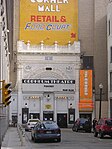Boston Music Hall
1852 establishments in Massachusetts1900 disestablishments in Massachusetts19th century in BostonCommercial buildings completed in 1852Concert halls in Massachusetts ... and 2 more
Music venues in BostonTheatres in Boston

The Boston Music Hall was a concert hall located on Winter Street in Boston, Massachusetts, with an additional entrance on Hamilton Place.One of the oldest continuously operating theaters in the United States, it was built in 1852 and was the original home of the Boston Symphony Orchestra. The hall closed in 1900 and was converted into a vaudeville theater named the Orpheum Theatre. The Orpheum, which still stands today, was substantially rebuilt in 1915 by architect Thomas W. Lamb as a movie theater. The hall has no connection with Boston's "Music Hall", a theater which is now known as the Wang Theatre.
Excerpt from the Wikipedia article Boston Music Hall (License: CC BY-SA 3.0, Authors, Images).Boston Music Hall
Hamilton Place, Boston Downtown Boston
Geographical coordinates (GPS) Address Nearby Places Show on map
Geographical coordinates (GPS)
| Latitude | Longitude |
|---|---|
| N 42.356222222222 ° | E -71.060833333333 ° |
Address
Orpheum Theatre
Hamilton Place 1
02108 Boston, Downtown Boston
Massachusetts, United States
Open on Google Maps










